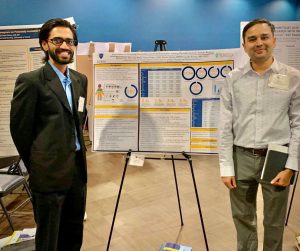Saving money on prescription medications might be as simple as leaving your insurance card tucked away in your wallet.
Researchers at The University of Toledo College of Pharmacy and Pharmaceutical Services recently published a study that compared the price of 20 commonly prescribed generic medications purchased through pharmacy discount card services from Amazon Prime and GoodRx against out-of-pocket payments made by patients.
They found about 20% of the prescription medications included in their analysis would have been less expensive through Amazon and more than 40% would have been cheaper through GoodRx.
Out-of-pocket payments refer to a patient’s share of the drug price — what’s not reimbursed by insurance or, in the case of those who are uninsured, the pharmacy’s cash price.

Dr. Varun Vaidya, a professor of pharmacy practice, is the senior author of a study looking at prescription drug costs that was recently published in the influential journal Annals of Internal Medicine.
Patients could, for example, save a median of $13.49 by purchasing their 90-day supply of the thyroid medication levothyroxine using the Amazon Prime discount card instead of going through insurance.
The research, which was published earlier this month in the influential journal Annals of Internal Medicine, highlights the value of pharmacy discount cards as a cost-saving resource.
However, the research also underscores a concerning issue: Patients should not be burdened with the task of hunting down the best prescription prices, especially for low-cost generics, when they are already paying insurance premiums.
“Prescription drugs can be expensive, but that’s not the whole story,” said Dr. Varun Vaidya, a professor of pharmacy practice and pharmacoeconomics researcher at UToledo. “Only about 10% of prescriptions are those expensive, brand-name drugs. The vast majority are generic drugs, but when consumers go through insurance, the entire process goes behind the curtain.”
The group’s analysis, which included individuals who had private insurance, Medicare or were uninsured, found that Americans could have cumulatively saved $969 million by using the Amazon discount card and more than $1.8 billion through GoodRx.
The average patient, Vaidya said, tends to think only of high-priced drugs when filling a prescription, believing they need to use their prescription drug coverage to even have a chance at affordability.
“That assumption kind of insulates them from even looking into the price of the drug,” said Vaidya, who was the study’s senior author. “It makes sense that people expect insurance should be the best route. However, this research proves patients are being put in an opaque, economically inefficient system where they often end up paying a lot more than they should have.”
The researchers conducted an analysis focusing on the 20 most frequently prescribed generic medications in the United States using a nationally representative dataset from the Medical Expenditure Panel Survey. The medications studied include common treatments for conditions that affect millions of Americans, including hypertension, high cholesterol, diabetes and depression.
“From a consumer standpoint there is the opportunity to lower cost, and the message really is to talk to your pharmacist, who could advise you on potential cost-saving opportunities,” said Dr. Pranav Patel, the paper’s lead author and an alumnus of both the Pharm.D. and Health Outcomes and Socioeconomic Sciences master’s program in the UToledo College of Pharmacy and Pharmaceutical Sciences.
Patel, who began the research while working toward his master’s degree at UToledo, said the largest benefits to using drug discount cards were seen by individuals who were uninsured and those who had not yet met their insurance deductible.
But more than providing information for patients, Patel and Vaidya say the research highlights the need for greater transparency on pharmaceutical pricing, reimbursement and policy reforms.

Dr. Pranav Patel, left, a two-time alumnus of the UToledo College of Pharmacy and Pharmaceutical Sciences, with Vaidya at a conference when he was a UToledo student. Patel partnered with Vaidya on the recent research.
“The goal of this paper is to have a conversation on the pharmaceutical reimbursement framework,” Patel said. “This adds to the growing body of evidence that our system isn’t really working as it’s supposed to, and that patients are suffering because of it. We need to see reforms that facilitate the adoption of value-based insurance designs.”
Patel said health policy discussions around the role of pharmacy benefit managers are a necessary part of that reform. Pharmacy benefit managers play a crucial role in managing drug prices and prescription claims within the healthcare system. However, there have been concerns about transparency in how they handle pricing, making it difficult for patients to understand the cost of medications, including common ones.
Until reforms happen, Patel and Vaidya say many patients can lower the cost of their prescription medications by comparing prices through platforms like Amazon Prime and GoodRx. Though not part of the analysis, Mark Cuban’s Cost Plus Drugs is another place to look, researchers say.
However, they acknowledge that pharmacy shopping can be inconvenient.
“Many patients might not be familiar with all the technical details about their medications, which means they often have to trust and rely on experts when seeking advice or making choices,” Vaidya said. “Because of this, they might find it hard to compare options or choose the best pharmacy for their needs.”
Additionally, pharmacists at multiple pharmacies may not have a complete list of your medications, increasing the risk of missing potential drug interactions, making it vital to consult with the pharmacist when filling a new prescription.
Whatever patients decide, researchers aren’t arguing that people should drop their prescription drug coverage.
“Insurance is needed. We still have these 10% prescriptions that are very expensive. If you get cancer, you’re not likely to be able to cover the cost of those medications without insurance,” Vaidya said. “The problem is that for many common medications, the average person doesn’t know when insurance is going to make a drug more or less expensive. That’s where some kind of reform needs to happen.”